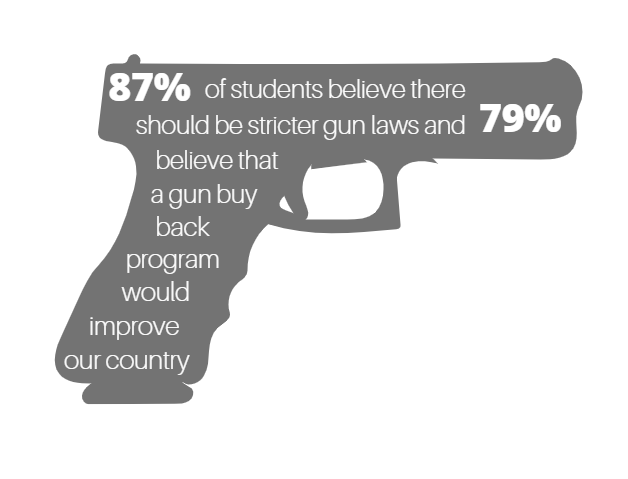A gun buyback program may not be the ideal solution
*survery out of 302 students
November 25, 2019
America is facing a crisis. According to The International Interest, there are an estimated 400 million privately owned guns in the U.S., with the rates of gun ownership remaining stagnant while the amount of guns owned increases. The Pew Research Center reports that in the years 2014-2017, gun-related murders increased 32%, while between the years 2006-2017, gun-related suicides increased 41%. The obvious correlations between an increase in gun sales and an increase in gun violence are concerning to many, but what’s even more concerning is the government’s lack of action.
“Both political parties [are] unwilling to take a stand because it’s not a ‘winning issue,’” English teacher Kevin Hickerson said. “You have few people out there willing to take principled stands.”
Despite the public’s overwhelming support of common sense gun laws, gun control is viewed as controversial and is neglected by the government in favor of the support of National Rifle Association lobbyists. When coupled with the increasing frequency of mass shootings, gun v
iolence is difficult to bring up in day-to-day conversations, causing the country to become progressively desensitized to the issue.
One solution that’s often brought up is a gun buyback program, and while such a program has never been utilized in America, other countries have implemented buyback programs, most notably Australia.
According to the National Center for Biotechnology Information, Australia refined its gun control policies after the Port Arthur shooting in 1996, which resulted in the death of 35 people. To prevent future mass shootings, all eight provinces almost immediately agreed upon the National Firearms Agreement (NFA) in a matter of 12 days. The agreement created a gun buyback program, and it banned the use of semi-automatic weapons and rifles and restricted gun rights to those who
had committed violent crimes in the past five years. Many Americans believe the U.S. should adopt similar policies.
“It seems like a good way to prevent bad people from getting guns,” sophomore Elise Engelen said. “However, I doubt many Americans who own guns would want to give their guns up. I’m not sure how we would implement those programs.”
The difficulty in enforcing a government-run buyback program is higher in America. The challenge stems from the larger quantity of guns owned in the U.S. The 650,000 firearms collected in Australia, which is approximately 20% of the guns owned there, would be equal to about 40 million in the U.S., as stated by Snopes. A decrease in the number of guns in America could potentially have incredible results when considering the deaths involving firearms. The Australian National University conducted
a study stating that the country experienced an 80% drop in firearm-related homicides after the policy changes. While these seem like phenomenal results, buyback programs aren’t without flaws.
According to the Los Angeles Times, in 2015, 36,252 firearms-related fatalities occurred in America, with 61% being suicides and the rest being homicides. Australia’s NFA was created to combat mass shootings, and while those have been on the rise in recent years in the U.S., an American gun buyback program might not be as impactful. According to the magazine Reason, there’s also the fear of another negative prohibition, since a black market for firearms, specifically the more dangerous ones, arose in Australia. One way to combat this rebellion could be a more gradual approach to gun control.
“Start locally, then scale up w
hile evaluating what’s working and what isn’t with regard to the implementation,” Physical Education teacher Philippe Brady said. “Doing a statewide or nationwide collection campaign would be a massive and expensive undertaking. If you go that route, it would be nice to have some assurances of success.”
In spite of the downsides, there is still a significant difference a buyback program could potentially have in reducing mass shootings, especially since 38 mass shootings have occurred just this year, as stated by The New York Times.
“It’s going to take a lot of youthenism in America,” Hickerson said. “The next generation is going to have to deal with the aftermath of my generation and the previous generation’s lack of willpower to take on issues that are killing us right now, literally and figuratively.”



